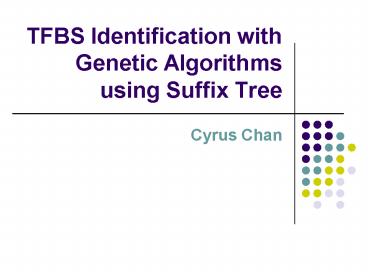TFBS Identification with Genetic Algorithms using Suffix Tree - PowerPoint PPT Presentation
1 / 17
Title:
TFBS Identification with Genetic Algorithms using Suffix Tree
Description:
TFBS Identification with Genetic Algorithms using Suffix Tree. Cyrus Chan ... CRP motifs: ... CRP 18 sequences of 105 bp. Locate some of the motifs. More generation is ... – PowerPoint PPT presentation
Number of Views:61
Avg rating:3.0/5.0
Title: TFBS Identification with Genetic Algorithms using Suffix Tree
1
TFBS Identification with Genetic Algorithms using
Suffix Tree
- Cyrus Chan
2
Biological Background
Transcription Factor
Expressed
Coexpressed Genes
TFBS motifs
3
Problem Description
Upstream Sequences
4
Related Methods
- Deterministic Methods
- (l, d)-motif discovery problem
- Weakly conserved motifs in real problemsl?
- Machine learning methods
- Training data or strong prior knowledge
- May bias the training data
5
Related Works
- Genetic Algorithms / Evolutionary Computation
- Consensus-led
- Evaluate the fitness of aligned subsequences
- Rely on additional techniques Alignments
Clustering - Positions-led
- Evaluate the fitness with a position matrix
- Can not locate similar motifs fast
6
GAST
- Genetic Algorithm using Suffix Tree (GAST)
- Combines positions and consensus
- Suffix Tree Content Addressable
- Generalized Suffix Tree For multiple sequences
- Locate motifs quickly
- Positions diversity
- Based on the similarities between different
motifsl need not be specified
7
Representation
Individual
Consensus
Positions
8
Genetic Operators
- Mutation
- Type1 randomly mutate the consensus with the
positions not completely preserved - Use suffix tree
- Type2 single mutation of the positions within an
individual - Multi-point?
9
Genetic Operators
- Single-point Crossover
- Performed on individuals in representation of
positions
10
Fitness Function
- Information Content
- G. B. Fogels Fitness score is also tried
Where fb,i is the observed frequency of
nucleotide b on the column i and pb (0.25) is
the background frequency of the same nucleotide.
The summation is taken over the four possible
types of nucleotides (b? A, T, C, G). l is the
motif length.
11
Selection
- K- Tournament
- Elitism is tried but the result is not good
premature convergence - K- Tournament adopted from G. B. Fogels work
- Each individual competes with K random ones
- Rank individuals by the wins
- Re-rank by Fitness if there is a tie
12
Rearrangement
- Take Advantage of Suffix Tree
- Rank each motif within an individual according to
its similarity to the consensus - Locate the occurrence of motifs in different
sequences with Suffix Tree from highest to lowest
similarity
13
Other Issues
- Deal with TATA box and Poly-A
- Penalize the fitness of an individual with T, A
percentage higher than a user defined threshold - Phase problem
- The solution is a shifted version of the optimal
one - Can not be handled by genetic operators
- Shift based on the gain of Information Content
14
Preliminary Experiments
- The experiment of GACluster Paul et al GECCO06
- CRP motifs
- The method with 3 motifs found outperforms the
binary GA, which finds no real motifs
True Motifs
15
Preliminary Experiments
- GAST is able to identify 5 motifs in the
sequences (Population 1000 Generation 500) - CRP 18 sequences of 105 bp
- Locate some of the motifs
- More generation is needed
16
Discussion
- Mutation Rate /Crossover Rate
- Convergence
- Evaluate Fitness?
- Structured motifs / Modules
Expressed
17
TFBS Identification with Genetic Algorithms using
Suffix Tree
- Thank You!
- Cyrus Chan































